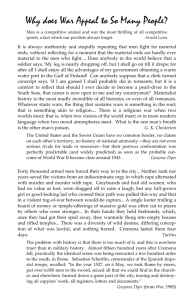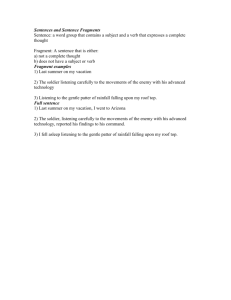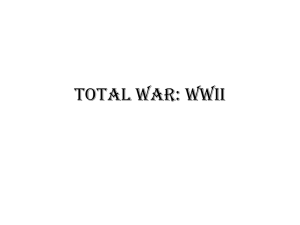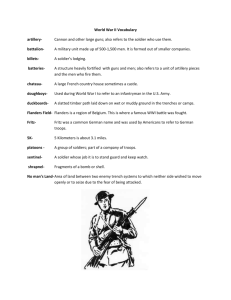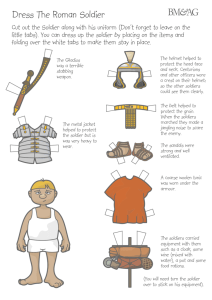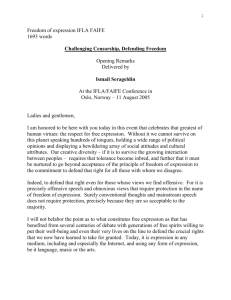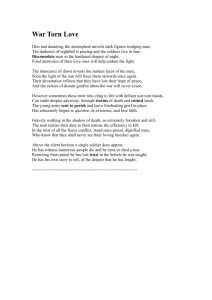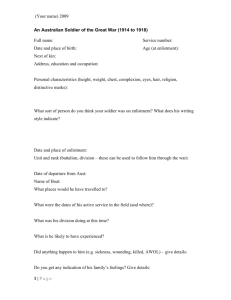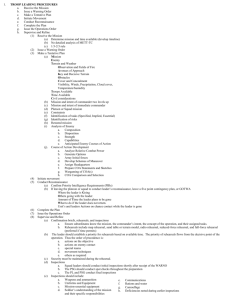Perform Movement Techniques During an Urban
advertisement
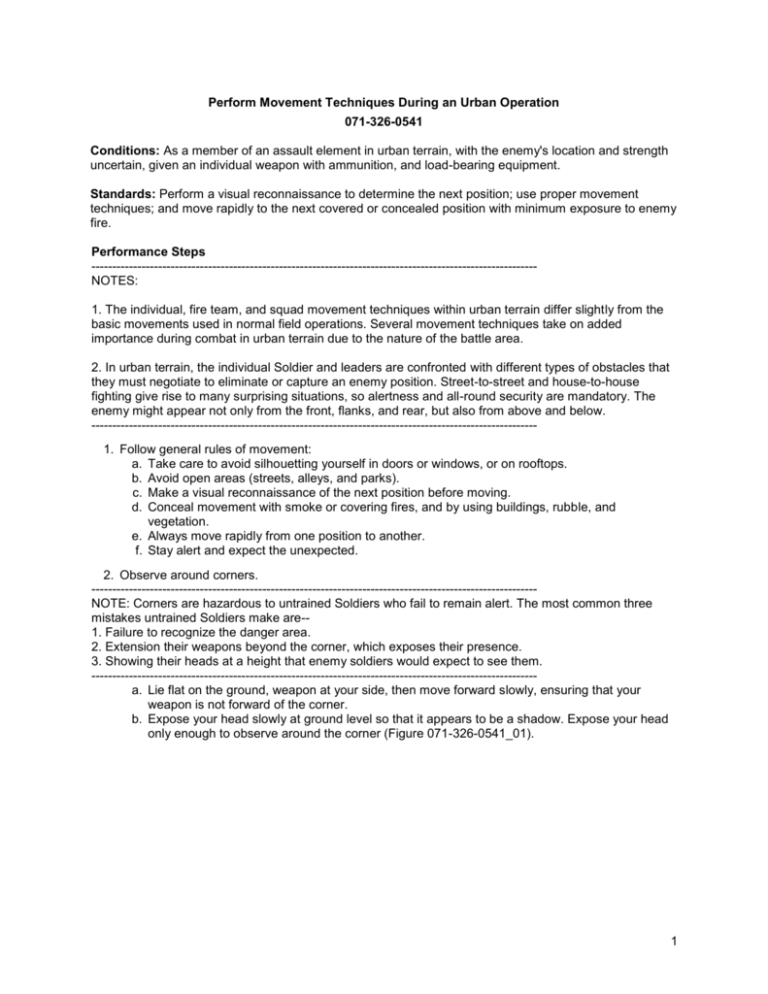
Perform Movement Techniques During an Urban Operation 071-326-0541 Conditions: As a member of an assault element in urban terrain, with the enemy's location and strength uncertain, given an individual weapon with ammunition, and load-bearing equipment. Standards: Perform a visual reconnaissance to determine the next position; use proper movement techniques; and move rapidly to the next covered or concealed position with minimum exposure to enemy fire. Performance Steps ----------------------------------------------------------------------------------------------------------NOTES: 1. The individual, fire team, and squad movement techniques within urban terrain differ slightly from the basic movements used in normal field operations. Several movement techniques take on added importance during combat in urban terrain due to the nature of the battle area. 2. In urban terrain, the individual Soldier and leaders are confronted with different types of obstacles that they must negotiate to eliminate or capture an enemy position. Street-to-street and house-to-house fighting give rise to many surprising situations, so alertness and all-round security are mandatory. The enemy might appear not only from the front, flanks, and rear, but also from above and below. ----------------------------------------------------------------------------------------------------------1. Follow general rules of movement: a. Take care to avoid silhouetting yourself in doors or windows, or on rooftops. b. Avoid open areas (streets, alleys, and parks). c. Make a visual reconnaissance of the next position before moving. d. Conceal movement with smoke or covering fires, and by using buildings, rubble, and vegetation. e. Always move rapidly from one position to another. f. Stay alert and expect the unexpected. 2. Observe around corners. ----------------------------------------------------------------------------------------------------------NOTE: Corners are hazardous to untrained Soldiers who fail to remain alert. The most common three mistakes untrained Soldiers make are-1. Failure to recognize the danger area. 2. Extension their weapons beyond the corner, which exposes their presence. 3. Showing their heads at a height that enemy soldiers would expect to see them. ----------------------------------------------------------------------------------------------------------a. Lie flat on the ground, weapon at your side, then move forward slowly, ensuring that your weapon is not forward of the corner. b. Expose your head slowly at ground level so that it appears to be a shadow. Expose your head only enough to observe around the corner (Figure 071-326-0541_01). 1 Performance Steps Figure 1. Observing around a corner. 3. Move across open areas. Avoid these areas, such as streets, alleys, and parks, when possible, because they are natural kill zones for enemy crew-served weapons. If you must cross an open area, reduce your risk by taking the following basic precautions: a. Make a visual reconnaissance of the area and position. b. Select a route that has some cover or concealment. If none is available, use smoke or covering fire provided by the rest of the element. c. Move by the most direct route to the selected position to reduce the time of exposure to enemy fire. Also, moving rapidly denies the enemy the chance to place well aimed shots. d. Move from position to position without masking covering fires. When you reach your next position, be ready to cover the movement of other members of your fire team or squad (Figure 071-326-0541_02). Figure 2. Moving from cover to cover. e. When two or more Soldiers must move at the same time to another position-- 2 Performance Steps (1) The group must prepare to position themselves to move to the next position. (2) On a planned signal, the group moves across the open area to the next position at the same time. They move about 5 meters apart (Figure 071-326-0541_03). Figure 3. Group moving to the next position. 4. Move parallel to buildings. a. Move along the wall as closely as possible to deny an enemy soldier inside the building the chance to fire at you. (1) Use all available cover and concealment, move with a low silhouette, and advance rapidly from position to position. If you have smoke, use it. (2) When possible, move into the shadows, which will help conceal your movement. b. Move past the first floor windows. ----------------------------------------------------------------------------------------------------------NOTE: Windows are danger points. Most first-floor windows are head high, and an unsuspecting Soldier will expose his head, giving the enemy an excellent shot from cover. ----------------------------------------------------------------------------------------------------------(1) The right way to pass first floor windows is to stay as close to the building as possible then, when you reach the window, duck your head well below it. (2) Always take care to avoid silhouetting yourself in a window (Figure 071-326-0541_04). 3 Performance Steps Figure 4. Movement past window. c. Move past basement windows. (1) Never just walk or run past a basement window. Your legs will present a good target to an enemy gunner inside the building. (2) The right way to pass a basement window is to keep as close to the building as possible and, when you reach the window, step or jump above and across the window without exposing your legs (Figures 071-326-0541_05 and 071-326-0541_06). Figure 5. Start of movement past basement window. Figure 6. Completion of movement past basement. 5. Cross obstacles (walls, fences, and rooftops). a. Move over walls and fences. (1) Before crossing a wall or fence, look at and beyond it for booby traps, enemy positions, and covered or concealed positions. (2) Move rapidly to the obstacle and roll quickly over it, keeping the lowest silhouette possible. Speed and a low silhouette deny the enemy a well aimed shot. (3) Move rapidly to the nearest position while maintaining a low silhouette, with your weapon at the ready position (Figure 071-326-0541_07). 4 Performance Steps Figure 7. Crossing of an obstacle. b. Move over rooftops. (1) Make a visual reconnaissance of the area and of the route to the next position. (2) Move rapidly across the area, maintaining a low silhouette and using all available cover and concealment. Evaluation Preparation: SETUP: At the test site, provide all materials and equipment given in the task condition statement. BRIEF SOLDIER: Tell the Soldier he will be moving as a designated member of an assault element in urban terrain. The enemy strength and location are unknown. Performance Measures GO NO-GO 1. Followed the general rules of movement. —— —— 2. Observed around corners. —— —— 3. Moved across open areas. —— —— 4. Moved parallel to the buildings. —— —— 5. Crossed obstacles. —— —— Evaluation Guidance: Score the Soldier GO if all performance measures are passed. Score the Soldier NO-GO if any performance measure is failed. If the Soldier scores NO-GO, show the Soldier what was done wrong and how to do it correctly. References Required Related FM 3-06 FM 3-06.11 5
